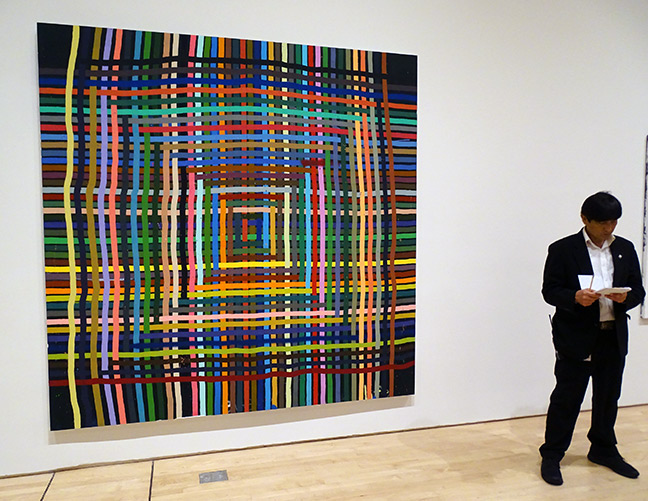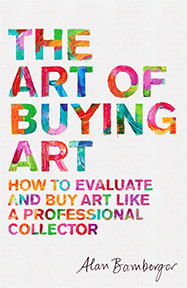How to Buy the Best Art:
Learn About the Artist, Then Buy the Art
Q: I was at an art auction preview last week and overheard two people talking about a painting in the sale. One said to the other that the painting was a late work and not worth bidding on. What is a late work, and are late works not worth buying or bidding on? More generally, how do you figure out whether a work of art is worth buying?
A: A late work refers to a work of art completed toward the end of an artist's career. Whether or not a late work is "worth bidding on" or buying depends on the artist. Late works can sometimes be commercial in nature, second-rate repeats of earlier successes, or may be inferior in other ways due to an artist's advanced age. In general, collectors prefer early or mid-career works of art, but not always. Late works by Grandma Moses, for example, are highly collectible and definitely worth bidding on.
Now to your broader question-- what makes a particular piece of art worth buying? In other words, what about a work of art makes it great or good or noteworthy in any respect? The answer in large part involves understanding the life, art and career of the artist who made it.
One of the most common errors novice art buyers make is buying without knowing much more than the names of the artists whose art they want to buy. They assume just because an artist is well-known, for example, that any work of art signed by them is valuable, and that the signature alone is adequate justification for buying. The truth is that it may be great and it may be awful. If you think for one instant that every single piece of art with a known artist's signature on it is automatically collectible, valuable or of superior in quality, watch out. You'll be fair game for those less-than-scrupulous sellers who would be delighted to sell you mediocre art for more than it's worth. Plenty of works of art by even the most famous artists are so subpar that no informed buyer would ever buy them, no matter how affordably priced they may seem.
Unfortunately, people overpay for inferior art all the time because they don't have enough experience looking at art and don't know enough about the artists to tell whether or not it's any good. In fact, the main reason poor quality art has any market at all is that people who have no idea what they're doing buy it. If you want to buy the good stuff and avoid the losers, you better learn how to tell the difference BEFORE YOU EVEN THINK ABOUT BUYING PIECE NUMBER ONE. Here's how:
* Search the Internet for information about the artist from as many different sources as possible. Get the big picture; don't stop after one or two websites and think you've done due diligence. Take advantage of every opportunity to see the work in person either at galleries, in collections, or at the artist's studio. Look through any catalogues, articles or reviews of the artist that you might come across-- whether in print or online-- as many as you can locate and from as many different sources as possible. Pay special attention to interviews or features about the artist, either online or in hard copy, and pay especially special attention to the images or illustrations that accompany those features because those are usually better quality examples of the artist's work.
* Follow the artist on social media and visit their website. See where they're showing, how productive they are, what their followers have to say about their art, what sorts of awards or distinctions or coverage they receive, how they're selling, and so on. But do the other research as well; simply following the artist is not enough.
* Talk with collectors who are familiar with the artist, galleries who sell or represent art by the artist, and even curators or critics if you get a chance-- whenever and wherever you can. Have them explain to you what makes the good art good and why.
* If you're fortunate enough to have the opportunity to speak or correspond directly with the artist, ask where you can find more information about their career and experience. If they're willing, ask them to briefly tell you about particular pieces or styles of their art that you like the most. Ask them about their most significant artworks and what makes them significant.
* Look at plenty of art by the artist-- as much as you can and wherever you find it. Your goal is to learn why one piece is more desirable or expensive, and the next one is not.
* Shop around. Get MULTIPLE opinions from MULTIPLE galleries, dealers and online sources BEFORE you buy. Do not settle exclusively on one gallery or dealer or resource, no matter how compelling their presentations may be. Wait until you have a good feel for the overall market before whipping out the wallet.
* Keep in mind that it's all about the art. No matter how gorgeous or well-appointed the gallery, how slick the website, or how convincing the seller, you want to make sure you're getting a quality work of art for your money.
* Corroborate all claims a seller makes regarding a particular work of art (or the artist who made it). Often you can simply ask the seller for information or data that substantiates what they're telling you; other times you may have to call out for second or third opinions, or go online. What you want are facts-- names, dates, prices, illustrations, essays, websites, etc. If you're not sure whether you've got enough information to go on, then wait until you are.
* Don't try to be clever and beat the bushes for bargains until you genuinely know what you're doing (if you only think you know what you're doing, then you don't). Rest assured that chances are good you will be taken to the cleaners if you do.
Getting your basic art education may sound like all work and no play, but it's really quite the opposite. If you like art, learning about it by hopping online and going places and looking at it, reading about it, and meeting interesting art people in the process is pure pleasure-- and great adventure. The fringe benefits, of course, are that the more legwork you do, the better informed you get, and the more discriminating you become as a buyer.
Back to your original question, all artists have periods in their careers when the art they create is generally considered to be better than the art they create during other periods-- early, late or somewhere in between. The more you know about an artist, the easier you can identify which periods those are, what the art produced during those periods looks like, where the best places are to find it, and what prices are fair to pay for it. To repeat-- this is knowledge you should acquire as you go from website to website, dealer to dealer, artist to artist, and gallery to gallery-- BEFORE YOU EVEN THINK ABOUT BUYING PIECE NUMBER ONE. Not only will you eventually find the art that's perfect for you, but you'll have plenty of fun and fascinating experiences along every step of the way.

(art by Alicia McCarthy)

Current Features
- How to Buy Art on Instagram and Facebook
More and more people are buying more and more art online all the time, not only from artist websites or online stores, but perhaps even more so, on social media ... - Collect Art Like a Pro
In order to collect art intelligently, you have to master two basic skills. The first is being able to... - San Francisco Art Galleries >>


